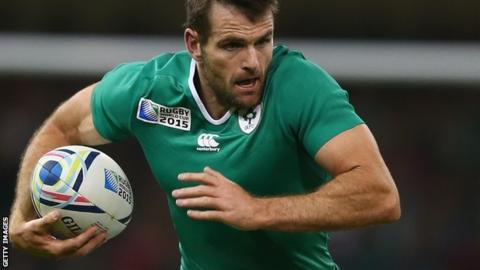Statistical analysis: Ireland's attacking mindset
- 3234

Guest blogger The Chase takes a look at how Ireland's attacking mindset can claim victory against the Boks.
In the aftermath of Connacht's Pro12 final victory a couple of weeks ago, a comment from Leinster's Jamie Heaslip was particularly interesting:
"I thought we got out the gate pretty well, but we probably made more mistakes on the day than they did. In these high-pressure games, it's the team that makes less mistakes and takes their opportunities that wins it. They're deserved winners, and I can't take away from their performance at all."
This analysis resonates strongly with the philosophy of Joe Schmidt's Ireland, particularly in attack: eliminate high-risk elements such as offloads, focus on ball retention at the breakdown, and create opportunities with ball in hand through excellent ruck speed. Consider Heaslip's statement in the context of Connacht's season, however - in particular the refreshingly unencumbered fashion in which they approached their first major final - and the diagnosis appears to miss the mark. Pat Lam's side have been the embodiment of playing without fear of making mistakes, and it was this very quality - the willingness to take a risk in attempting to create opportunities, rather than setting up phases and waiting for them to appear - that was the driving force behind their historic season.
The western province's campaign could not have provided a more stark counterpoint to the spectacle of Ireland's international performances over the past 9 months, and has placed the approach of Ireland's Kiwi head coach under an immense amount of scrutiny. But despite yet another raft of injuries decimating his squad (including the loss of his linchpin, fly-half Jonny Sexton) this month's test series against South Africa is unlikely to see an overhaul of his tried and trusted methods. Nevertheless, it is interesting to considering Ireland's recent attacking performance in the context of the criticism Schmidt has had to endure - and of this notable post-match comment from one of his most trusted lieutenants.
Last autumn's Rugby World Cup was marked in a similar fashion to the Pro12 Final by correlation between success and positive, attacking rugby; the four SANZAAR semi-finalists outscored their Northern Hemipshere opponents by 19 tries to 7 at the quarter-final stage. The chart below plots the percentage of carries resulting in clean breaks (a reasonable proxy for attacking effectiveness) against the average world ranking of a team's World Cup opponents during the tournament for the 6 Nations and Rugby Championship countries:
Australia, Argentina and New Zealand occupy three of the top four slots in terms of clean break % for the tournament, while Ireland's position makes for grim reading: despite facing on average the lowest ranked opponents throughout the tournament, they averaged the fewest clean breaks per carry of any country. For reference - with the caveat that, for the Northern Hemisphere nations, early spring weather conditions seem to preclude the intent to play attacking rugby - Ireland's figures for clean break % over the past three 6 Nations championships have been 5.9% (2016), 3.6% (2015) and 4.8% (2014). Some will argue that the silverware speaks for itself, but England's path to the grand slam in the 2016 - on the back of a well-executed but limited gameplan put in place by new coach Eddie Jones - serves as a rather strong condemnation of the continent's international quality over this period.
As for Heaslip's comments, how did success stack up against the elimination of mistakes over the course of the tournament? One way we can look at this is by examining the ratio of handling errors to total passes and offloads; there are of course other facets of the game to which the number 8 refers when he talks about mistakes, but in the context of this discussion it is a reasonable metric to discuss. Below, this figure for each team ('Handling error %') is charted against their clean break %:
Ireland minimised their handling errors while maintaining a high number of passes per carry (1.37 - only New Zealand, with 1.44, averaged more), but most notable is the fact that the attacking success of Australia, Argentina and New Zealand goes hand in hand with a handling error % figure that is above average. As we saw with Connacht in the Pro12, success for these teams in the World Cup was likely more to do with a focus on the creation of opportunities than the elimination of errors, and an acceptance of a certain level of error as a necessary by-product.
As has been noted above, it would be extremely surprising and perhaps irresponsible for Joe Schmidt to make wholesale changes to Ireland's strategic approach in the short term. Long-term injuries to key ball-carriers like Sean O'Brien and Iain Henderson have undoubtedly been detrimental to the development of an incisive and effective attack in recent times, but the reality is that the team have not been able to create line breaks effectively for the entirety the head coach's tenure. The return of Henderson on Saturday in Cape Town may provide some much needed go-forward in the pack, and the additions of Healy, Gilroy and O'Halloran has generated some additional excitement around the squad; for Schmidt, however, the system is king, and an attack that is markedly more effective may be too much to expect from new personnel within the same overall structure.


















